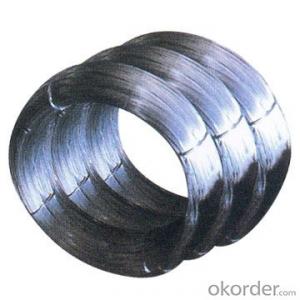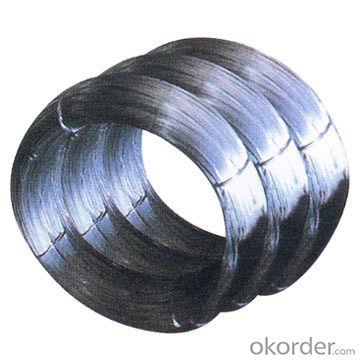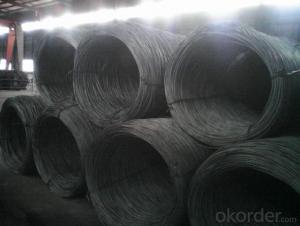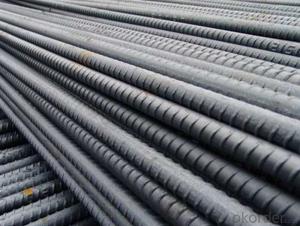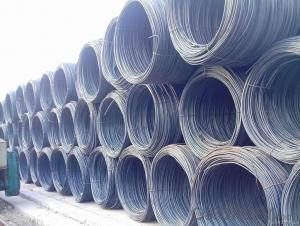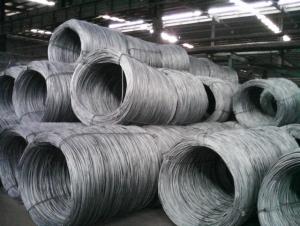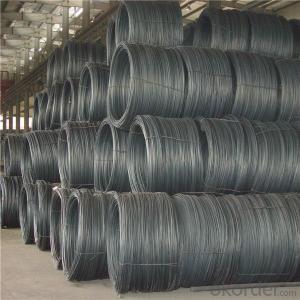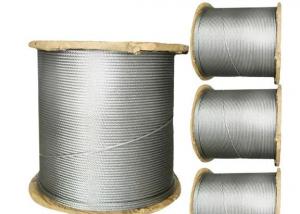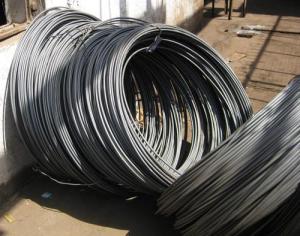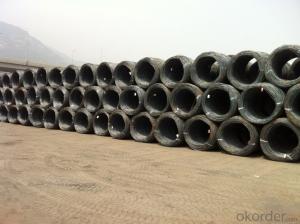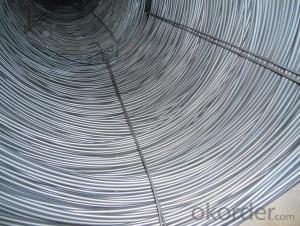Good quality oil temper spring steel wire
- Loading Port:
- Shanghai
- Payment Terms:
- TT OR LC
- Min Order Qty:
- 50 m.t.
- Supply Capability:
- 10000 m.t./month
OKorder Service Pledge
OKorder Financial Service
You Might Also Like
Quick Details
Steel Grade: 45#, 60#, 65#, 70#, 72A, 72B, 82B, 65Mn
Standard: AISI, ASTM, BS, DIN, GB, JIS
- Type: Spring
Application: Construction
Alloy Or Not: Non-alloy
- Diameter range: 0.02-16mm
Standard: AISI, ASTM, DIN, GB, JIS, SUS
Packaging & Delivery
| Packaging Details: | Coils Packing, spools packing, or according to the customers' requirements |
|---|---|
| Delivery Detail: | 10-20days after confirm the order |
Specifications
16mm spring steel wire
1.Diameter range:0.02-16mm
2.Main application:making spring,mattress,wire
carbon steel wire ,Good quality oil temper spring steel wire
| Grade | 201,202,301,304,304L,310S,316,316L,410,430,etc. |
| Diameter | 0.02-16mm |
| Standard | AISI, ASTM, DIN, GB, JIS, SUS |
| Weight | According to the customers' requirements |
| Uses | To produce springs, steel wire ropes, brush and other uses |
| Packing | Coils Packing, spools packing, or according to the customers' requirements |
Terms:
1) Loading Port: Shanghai
2) Delivery term: FOB,CFR, CIF
3) Delivery lead time: 10 working days after received deposit.
4) Payment term:30% by T/T as deposit., balance will be paid by T/T before loading,
5) Quality assurance: Mill Test Certificate is supplied with shipment, third Party Inspection is acceptable.
- Q: What are the main factors affecting the price of steel wire rod?
- The main factors affecting the price of steel wire rod include the cost of raw materials, such as iron ore and scrap metal, as well as energy prices and transportation costs. Market demand and supply dynamics also play a significant role, along with global economic conditions, trade policies, and currency fluctuations. Additionally, factors like production capacity, technological advancements, and government regulations related to environmental and safety standards can impact the price of steel wire rod.
- Q: What are the common safety guidelines for steel wire rod usage?
- The common safety guidelines for steel wire rod usage include wearing appropriate personal protective equipment (PPE), such as gloves, safety glasses, and steel-toed boots, to protect against cuts and injuries. It is important to inspect the wire rod for any defects or damages before use and to handle it with care to prevent accidental injuries. Workers should be trained in proper handling techniques and understand the potential hazards associated with steel wire rods, such as sharp edges and potential entanglement risks. Additionally, it is crucial to store wire rods in a secure and organized manner, away from walkways and areas where they may cause tripping or falling hazards.
- Q: What are the main challenges in manufacturing steel wire rod?
- Some of the main challenges in manufacturing steel wire rod include ensuring consistent quality and strength, maintaining a high level of productivity, managing energy consumption and environmental impact, and addressing safety concerns in the production process. Additionally, market fluctuations and competition pose challenges in terms of pricing and meeting customer demands.
- Q: How is steel wire rod used in the manufacturing of wire forms for packaging?
- Steel wire rod is an essential material used in the manufacturing of wire forms for packaging. It serves as the base material for creating various wire products that are widely used in packaging applications. One of the primary uses of steel wire rod in packaging is the production of wire baskets and racks. These wire forms are commonly used for storing and transporting goods, providing a sturdy and reliable solution for packaging needs. The steel wire rod is processed and shaped into different forms and sizes to create these wire baskets and racks, which are then used for organizing and protecting various packaged items. Additionally, steel wire rod is also utilized in the production of wire hooks and clips. These wire forms are often used to secure packaging materials, such as plastic bags or boxes, preventing them from opening or spilling their contents during transportation. The durability and strength of steel wire rod make it an ideal material for creating these hooks and clips, ensuring that packaging remains intact and secure. Moreover, steel wire rod is employed in the manufacturing of wire ties, also known as twist ties or bag closures. These wire forms are commonly used in the packaging industry to seal bags, bundles, or packages, providing a simple yet effective way to keep items tightly sealed and protected. The flexibility and malleability of steel wire rod allow for easy bending and shaping into twist ties, making it an essential component in their production. Overall, steel wire rod plays a crucial role in the manufacturing of wire forms for packaging. Its strength, durability, and versatility make it a preferred material for creating various wire products used in packaging applications, such as baskets, racks, hooks, clips, and twist ties. By utilizing steel wire rod, packaging solutions can be designed to withstand the rigors of transportation and ensure the safe and secure handling of goods.
- Q: What are the main factors influencing the choice of steel wire rod order payment refund options?
- The main factors influencing the choice of steel wire rod order payment refund options include the terms and conditions of the purchase agreement, the level of trust between the buyer and seller, the reputation and financial stability of the supplier, the ease and cost of implementing different refund options, and the overall market conditions and industry practices.
- Q: How is steel wire rod used in the manufacturing of wire mesh conveyor belts?
- Steel wire rod is used in the manufacturing of wire mesh conveyor belts as it serves as the primary material for the production of wire mesh. The wire rod is drawn into thin wires, which are then woven together to form a mesh pattern. This mesh structure provides strength, flexibility, and durability to the conveyor belts, allowing them to withstand heavy loads and high temperatures commonly encountered in industrial applications. Additionally, the steel wire rod's corrosion resistance and high tensile strength make it an ideal choice for constructing conveyor belts that can efficiently transport materials in various industries such as mining, food processing, and automotive manufacturing.
- Q: How are steel wire rods used in the production of fishing lines?
- Steel wire rods are used in the production of fishing lines to provide strength and durability. These rods serve as the core or backbone of the fishing line, providing it with the necessary tensile strength to withstand the weight and pressure exerted by large fish. The steel wire rods used in fishing lines are typically made from high-quality stainless steel, which ensures resistance to corrosion and rust. This is crucial as fishing lines are constantly exposed to water and moisture, which can degrade the material over time. During the manufacturing process, the steel wire rods are coated with a protective layer, such as nylon or polymer, to enhance their performance and make them more suitable for fishing purposes. This coating not only provides additional strength but also increases the line's flexibility, making it easier to cast and retrieve. The steel wire rods are also responsible for determining the fishing line's overall diameter and weight. Thicker rods will result in a heavier and stronger line, while thinner rods will produce a lighter and more sensitive line. This allows anglers to choose a fishing line that best suits their specific needs and fishing conditions. Moreover, the use of steel wire rods in fishing lines provides increased sensitivity, allowing anglers to detect even the slightest nibbles or movements by the fish. This is especially important in situations where fish are more cautious and require a delicate approach. In summary, steel wire rods play a vital role in the production of fishing lines by providing the necessary strength, durability, and sensitivity. They serve as the foundation of the line, ensuring it can withstand the weight of large fish and resist the effects of water and corrosion.
- Q: How is steel wire rod used in the manufacturing of wire for geotechnical applications?
- Due to its exceptional strength, durability, and versatility, steel wire rod finds wide application in the manufacturing of wire for geotechnical purposes. Geotechnical applications mainly involve soil stabilization, erosion control, and reinforcement of structures in civil engineering projects. To begin with, geogrids are produced using steel wire rod, which are high-strength structures made of woven or welded wire mesh. Geogrids are utilized to reinforce soil and provide stability in various applications like retaining walls, embankments, and slopes. The steel wire rod is shaped into a mesh pattern and then coated with a protective material to enhance its resistance against corrosion and environmental factors. Furthermore, steel wire rod is employed in the production of steel strand cables, which are crucial in geotechnical engineering for post-tensioning purposes. These cables are applied to reinforce concrete structures such as bridges, buildings, and foundations. The steel wire rod is twisted into strands and then bundled together to form a cable with high tensile strength. This cable is embedded in concrete and post-tensioned to offer additional support and prevent structural failure. Additionally, steel wire rod is utilized in the manufacturing of gabions, which are containers made of wire mesh and filled with stones or other materials. Gabions find widespread use in erosion control, slope stabilization, and retaining walls. The steel wire rod is woven or welded to form a mesh cage-like structure, which is subsequently filled with stones. The gabions provide a flexible and permeable structure capable of absorbing impact, preventing soil erosion, and stabilizing slopes. In conclusion, steel wire rod plays a pivotal role in the manufacturing of wire for geotechnical applications. Its strength, durability, and adaptability make it an ideal material for reinforcing soil, stabilizing slopes, and reinforcing structures. Whether in the form of geogrids, steel strand cables, or gabions, steel wire rod significantly contributes to the safety, stability, and longevity of various geotechnical engineering projects.
- Q: How is steel wire rod tested for resistance to galvanic corrosion?
- Steel wire rod can be tested for resistance to galvanic corrosion through various methods such as salt spray testing, electrochemical testing, and accelerated corrosion testing. These tests involve subjecting the wire rod to corrosive environments or simulating corrosive conditions to evaluate its performance and ability to resist galvanic corrosion.
- Q: What are the main factors influencing the choice of steel wire rod coating?
- The choice of coating for steel wire rods is impacted by several key factors: the intended use, environmental conditions, durability needs, and cost considerations. First and foremost, the intended application of the wire rod is crucial in determining the appropriate coating. Different coatings offer specific properties like corrosion resistance, lubricity, or electrical conductivity. For instance, if the wire rod will be used outdoors or exposed to moisture, a corrosion-resistant coating like zinc or zinc-aluminum is preferred. On the other hand, if the wire rod is intended for electrical purposes, a coating with high electrical conductivity may be necessary. Secondly, the environmental conditions in which the wire rod will be utilized also play a significant role in coating selection. Factors such as temperature, humidity, exposure to chemicals, and UV radiation can impact the coating's performance and durability. Therefore, coatings that exhibit excellent resistance to these environmental factors are often chosen. Durability requirements are another influential factor. Depending on the wire rod's intended lifespan and the level of wear and tear it will face, different coatings with varying levels of durability may be chosen. Some coatings, such as epoxy or polyurethane, offer exceptional resistance to abrasion and impact, making them suitable for applications involving frequent handling or harsh environments. Lastly, cost considerations are important in coating selection. Different coatings come at different price points, and the cost must be balanced with desired performance and durability. It is crucial to choose a coating that meets requirements at a reasonable cost, ensuring a cost-effective solution without compromising the wire rod's performance. In conclusion, the choice of coating for steel wire rods hinges on the intended application, environmental conditions, durability needs, and cost considerations. By taking these factors into account, manufacturers can select the most suitable coating that provides the necessary properties and durability for the specific application while remaining cost-effective.
Send your message to us
Good quality oil temper spring steel wire
- Loading Port:
- Shanghai
- Payment Terms:
- TT OR LC
- Min Order Qty:
- 50 m.t.
- Supply Capability:
- 10000 m.t./month
OKorder Service Pledge
OKorder Financial Service
Similar products
Hot products
Hot Searches
Related keywords
